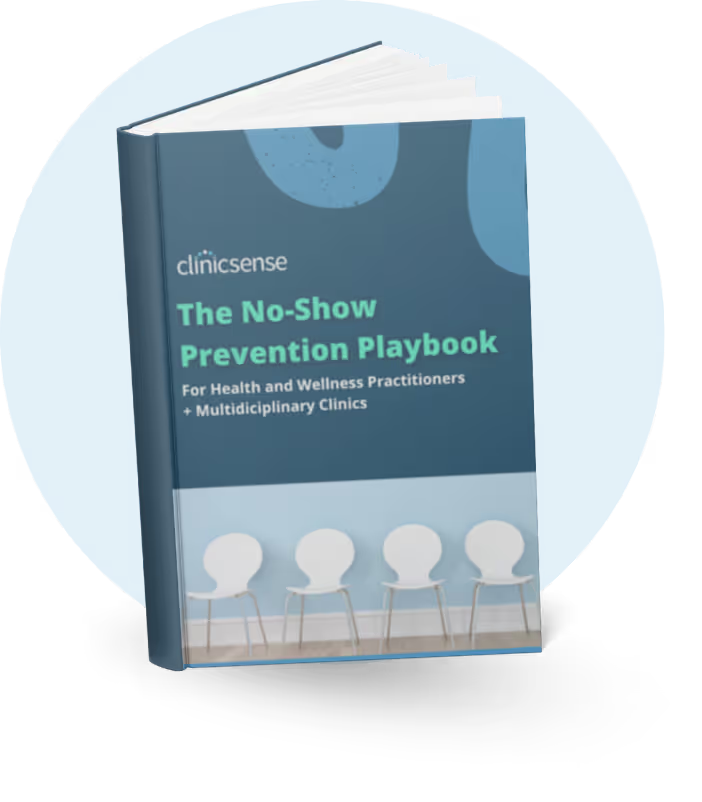No-Show Prevention
March 7, 2023

It may seem too good to be true, but adding one simple request to your appointment reminders can reduce your no-show rates. What’s that request and why does it work? That’s what we’re going to share in this article. But first, let’s talk about why you should care about your no-show rate.
The main reason to avoid no-shows or last minute cancellations is that when your client leaves you standing in the treatment room empty-handed, you lose money. Aside from that, it’s just plain frustrating. You’ve planned for that appointment, maybe even brought in staff for coverage, and now that time and cost is wasted. Plus, you’ll now have to expend more time following-up with your absent client to reschedule and may throw your client’s treatment plan off track.
To help you combat no-shows, we developed the No-Show Prevention Playbook. This free resource details how to create and enforce a bullet-proof cancellation policy. It also includes tips for how to avoid having to enforce your cancellation policy. Because no one wants to have to scold their clients. Everyone is much better off if clients keep their appointments and no-shows never happen.
One of the strategies we recommend in the playbook is to send appointment reminders.
Appointment reminders help you overcome the common no-show excuse of “I forgot.” They also give you an opportunity to communicate with your clients. Take advantage of this opportunity to remind them of your policy and how much you are looking forward to seeing them.
Reminders are also a great vehicle to emphasize the importance of their treatment plan or to mention some exciting new product or service they may want to try. Think outside the boring boilerplate when you create your message--just don’t forget to keep the appointment details as the focus.
Oh, and be sure to include a request that they confirm their appointment. Here’s why and how.
Everyone understands the basics of an appointment reminder. You call, email or text your client to remind them that they have an upcoming appointment. As we mentioned, your reminder should include all the important details such as the date and time and how to get in touch with you if the client needs to contact or reschedule.
What will make your reminders even more effective, though, is a request for a reply.
Make your appointment reminders a two-way exchange. Ask the client to confirm the appointment or take action to cancel or reschedule it. This simple step not only helps your clients remember their appointments better, but also makes it more likely that they will show up.
Why? Well, the more often and more actively we visit a topic, the greater its impact on our mind. A one-way message that says, “Hey, don’t forget,” is easier to dismiss or forget than a two-way interaction. Asking your client to affirm their commitment to keep their appointment reinforces that commitment.
Receiving a confirmation (or a reschedule request) from your clients also helps you and your staff. When your clients reply, you can be sure they received your reminder.
To get that confirmation, you should try to use a method of communication that makes it convenient for your clients to respond. Before choosing a channel, we recommend asking your clients which channel they prefer. If they don’t indicate a preference, then text messaging is the best way to ensure that your reminder is received.
What about just calling them? Calling clients on the phone to remind them of their appointments is time-consuming and leaving voicemails for those you can’t reach is risky. A recent study found that 19% of millennials never check their voicemails.
Email reminders are more effective than calls, and allow your clients to reply and confirm their appointments at their convenience. But, about 20% of your reminder emails may go unopened. Also, people tend to let emails linger in their inboxes. So your clients may open your timely-sent reminder too late to prevent a no-show.
In contrast, text messages almost always reach their target, and consumers appreciate getting appointment reminders via text.
We mentioned time as one of the drawbacks of calling clients to remind them of upcoming appointments, but emails and texts can cause this problem too. You only have so much time in your day, so you have to use it wisely. Automating your appointment reminders optimizes your time use and ensures that your reminders are sent at the right times.
Automated appointment reminders is one of the features included in the ClinicSense suite of massage practice management tools. Using ClinicSense, you can send email or text reminders that ask your clients to confirm their appointment and keep their commitment. Start a free trial to see how our massage therapy software can help you!

.avif)
.avif)
.avif)









For 14 days